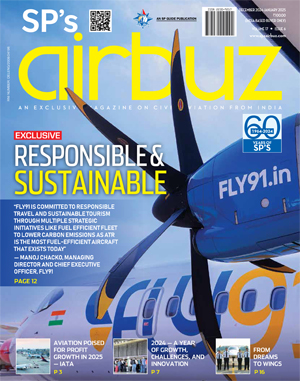Trends Shaping Regional Aviation
Increased urbanisation and prosperity in Tier-II and Tier-III cities is going to spur demand for regional air travel.

One of the most noticeable trends impacting the aviation industry at least in the developing world is the growing necessity and aspiration of people for air travel from smaller towns to major cities within the country and beyond. This is the single most important factor that determines strategies adopted by regional carriers and the manufacturers of regional aircraft to exploit the largely untapped segment. The next 10 to 15 years will see significant growth in regional aviation in China, India, Brazil and other countries. Increased urbanisation and prosperity in Tier-II and Tier-III cities is going to spur demand for regional air travel. Airlines and airports have now begun to take cognizance of the evolving situation and are engaged in formulating response.
Modernisation of Regional Airports
Regional aviation is getting a major boost on two counts – airport expansion/modernisation and travel convenience. While in the developing countries efforts are on to network remote areas, in the developed world, regional airports are becoming popular for a couple of reasons. For instance in the UK, regional airports are witnessing increasing number of flyers as there is trend among passengers to use less crowded airports for their domestic travel options. A 2005 survey by the UK Civil Aviation Authority (CAA) indicated that a huge 95 million holidaymakers hopped on a flight at a regional airport, a nine per cent increase from the previous year, while the bigger airports such as the Heathrow had slower rate of growth. In the last couple of years, passenger numbers at regional airports have been affected with the UK Government increasing flight tax.
The scenario is completely different in India and China where the governments have enunciated policies to promote air travel on a pan-country basis and accordingly are investing in regional airport development. The Civil Aviation Administration of China has embarked upon building 82 new airports and expanding 101 by 2015, thus taking the total airports in China to 230. About 80 per cent of the population will be within 100 km of an airport. In India, the government is coming up with a policy to push connectivity of remote areas and it has identified 50 small towns and cities for establishing new airports or modernising existing ones. The Airports Authority of India has set in motion work on 35 non-metro airports.
Seat Configuration
The airport expansion plans have started positively impacting airlines as they see increased movement of passengers from regional airports. Accordingly, the dynamics of seat configuration has come into play and regional airlines are factoring present and future capacities. In the light of this, the 50-seater aircraft has come under a lot of pressure and may have limited utility in the years to come.
In the 1990s, the 50-seater aircraft was seen as the answer to enhanced connectivity and the trend continued for almost two decades. With dramatic shifts in the recent past for air travel, driven by large scale migration and hinterland development, the segment that is anticipated to grow the fastest is the 60- /120-seat category. For airlines, the core lies in maximising passenger yield and minimising operating costs for any market and that can be a delicate balancing act to decide on right-sized equipment. Presently, as per Embraer Commercial Jets, market volumes requiring 70- /110-seat jets are being served inefficiently due to the industry’s lack of optimised aircraft. A larger jet can spread its fuel costs and overhead over more seats, reducing unit cost.
Tailwinds, a special publication of PwC has mentioned that the move to larger jets is already underway, as evidenced by the moves of Delta which closed down its subsidiary Comair and has renegotiated its deal with Pinnacle Airlines nearly doubling its number of large planes. Delta has indicated that it will phase out the small planes and is purchasing 90-seat and leasing 100-seat jets.
Bombardier, one of the two principal manufacturers of the 50-seat jet, maintains that the 60- /to 90-seaters have started to take hold, with more than 200 aircraft delivered in 2011. It projects that by the end of 2031, the total fleet of 60- to 90-seaters will expand to 6,800 aircraft.
Trends in India
According to an AT Kearney Report, in the short-haul aircraft segment in India, the dominance will be by ATR 72 and Bombardier Q-400 (60-90 seat turboprops) on routes below 500 km and regional jets will become a viable alternative to turboprops for less than 1,000 km routes. Regional jets will also dominate the 1,000 to 1,500 km routes between metros and Tier-II and Tier-III cities, for which there are the E-190/195, Bombardier CRJ -900/1000 and CSerices, AVIC ARJ-21, MRJ and Sukhoi Superjet, all catering to the 90- /120-seat segment.
India’s regional fleet is expected to grow from 55 in 2011 to as many as 261 by 2025. The growth mirrors the trends seen in other markets, especially the European Union, where the share of regional available seat kilometres (ASKs) has grown to about 14 per cent. Regional ASK has grown by about two per cent worldwide in the past five years, a rate India’s airline industry is expected to experience over the next decade.
Customer-centric Offerings
Along with seat capacities, the manufacturers are looking at faster, comfortable and quieter jets as airlines are propositioning them to expand their customer base. Even while most of the regional airlines fall in the no-frills category, there is no denying the fact that the services, both on ground and in air, are in line with aspirations of the travelling public and price positioning. As regional airlines operate short to medium haul routes, they do factor in meals on flight, seat selection, frequent flyer benefits, discounts, business lounges etc. India’s newest regional airline Air Costa offers economy plus seats along with economy class. It operates Embraer’s E-170 and E-190 jets which has no ‘middle seat’ and has a wider aisle and best-in-class leg room.the economy plus is in two plus one seat configuration.
Pleasing Aircraft Interiors
Experiencing a business class service from a small regional airport through to a final international destination is no longer a pipe dream. “In the US there is a strong trend for regional airlines to offer more ‘major airline’- like service with enhanced in-flight service including Wi-Fi,” said Kelly Murphy, spokeswoman for the Regional Airline Association (RAA). “In particular, regional airlines are also upgrading their aircraft interiors to dual-class configuration in both regional jets and turboprops, like the ATR-72 and Bombardier Q-400. US Airways Express, for example, has added First Class service to 110 of its regional jets including the Embraer-170/175 and Bombardier CRJ-700/900 fleet.”
SkyWest Airlines’ President and COO, Russell Childs confirmed the trend by stating that “Major regional carriers are very motivated by dual-class configurations of aircraft.” He also predicted that the regional industry was going to continue to grow into larger aircraft.
Vern Alg, Industry Consultant to Aircraft Interiors Expo said: “Regional airlines’ move towards dual-class offerings is great news for both passenger choice and the cabin interiors industry. It will be interesting to see whether these enhanced service levels have an impact on catering and onboard amenities. It could be that things like galleys and onboard stowage could come under increased pressure due to the raised service levels required by these dual-class configurations.”
Overall, customer needs and aspirations are becoming central to the changing trends of not just regional aviation, but also the mainline carriers and general aviation.





